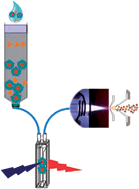 New Nanoscale communication
New Nanoscale communication
Laura Trapiella-Alfonso, Antonio R. Montoro Bustos, Jorge Ruiz Encinar, Jose M. Costa-Fernandez, Rosario Pereiro and Alfredo Sanz-Medel
Nanoscale, DOI: 10.1039/c0nr00822b
Alfredo Sanz-Medel and co-workers at the University of Oviedo, Spain have developed a new strategy for analysing the quality of water soluble and bioconjugated quantum dots.
Their work is a novel concept based on size exclusion chromatography (SEC) coupled with elemental and fluorescence detection. Traditionally, it has been difficult to analyse the quality of quantum dot constructs in a quantitative fashion with methods such as transmission electron microscopy and photoluminescence spectroscopy. The current work aims to provide a general platform which allows a much greater understanding of the quality of quantum dots after water solubilisation and bioconjugation.
Although quantum dots exhibit many excellent properties for use in biomedical imaging, such as bright fluorescence and narrow emission lines, it is vital that these innately hydrophobic particles can be dispersed in water using a reliable capping procedure. Furthermore, for them to be used as functional probes in biological environments they need to be conjugated to other molecules, such as proteins or antibodies. As these steps are vital for development of quantum dot-based biomedical probes, there is an urgent need for advanced methods of purification and characterization of quantum dot bioconjugates, such as the one developed by this group.
Read more about this exciting work here.










